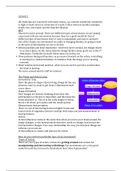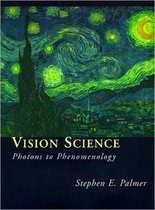Lecture 1
All textbooks are concerned with static vision, e.g. contrast sensitivity: sensitivity
to light or dark varies as a function of a scale. Colour vision is another example,
depth cues, stereopsis, and the thatcher illusion.
BUT
Observers move around. There are different types of movement; we are mainly
concerned with eye movements because they are a good model for lots of
different types of movement, they're easy to manipulate and easy to measure.
One of the classic eye movements we make is changing fixation, so going to look
at the sorts of information we use to do this.
Motion parallax and head translation- observers move around, the things closest
to us move faster on the retina than the things further away, good cue to the 3 rd
dimension. Textbooks on static vision miss out on this cue.
Flow patterns during self-motion- as you move forward on the retina, everything
is moving in a consistent fashion, it emulates from the image you're moving
towards.
Head rotation and sound position- what cues are used to perceive sound when
the head is moving.
We move around and do stuff we interact.
The Vision and Action Loop:
Invented by Tom.
Have the generic stages of perceiving, things hit the eye,
photons come in, want to get from 2 dimensions back
out to three.
Image Formation:
How images are formed, thinking about how this
information is relevant or important, and then how the
brain measures it. This is in the early stages of vision.
Know a lot about perception and the visual system.
Measurement-Interpretation:
There is a lot of interacting between higher levels and
lower levels of cognition (arrows could go both ways, not just measurement to
interpretation).
Action:
Action influences vision in the sense that when you move your head around, the
image changes, so the measurement therefore needs to change, and in turn the
interpretation changes. Two-way relationship, the way you interpret things can
influence your actions.
Action influences vision; and vision is for action.
How do you control a particular type of eye movement?
Types of Action:
There are two types of action; actions for getting around and actions for
manipulating and interacting with things. Eye movements are a very good
model for activity, but need to think about how/does it generalise?





